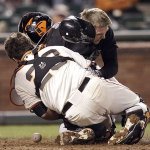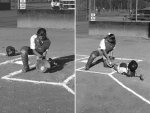Making the Tag at Home Plate Without Getting Hurt- Molina's Example!
I am a big advocate of having catchers avoid colliding with the runner trying to score. We see this a lot in the major leagues and in college ball. Even some fastpitch coaches instruct their catchers to block the plate with runners trying to score. There is a better way.
We work with catchers to set up off the line and out of the path of the runner coming in. From there the catcher can first catch the ball and rotate towards the runner to sweep the tag. We teach our catchers to use a two-handed tag whenever possible to avoid having the ball jarred loose during the tag. Besides avoiding colliding with the runner, the catcher can continue coming around and come up ready to throw and looking to get another out.
Yadier Molina provided an excellent example in game three of the world series by getting the out at home and avoiding the collision. Molina even gets the out while keeping his mask on.
Chaz at ACC
[video=youtube_share;qIPBaOJ9lXY]http://youtu.be/qIPBaOJ9lXY[/video]
I am a big advocate of having catchers avoid colliding with the runner trying to score. We see this a lot in the major leagues and in college ball. Even some fastpitch coaches instruct their catchers to block the plate with runners trying to score. There is a better way.
We work with catchers to set up off the line and out of the path of the runner coming in. From there the catcher can first catch the ball and rotate towards the runner to sweep the tag. We teach our catchers to use a two-handed tag whenever possible to avoid having the ball jarred loose during the tag. Besides avoiding colliding with the runner, the catcher can continue coming around and come up ready to throw and looking to get another out.
Yadier Molina provided an excellent example in game three of the world series by getting the out at home and avoiding the collision. Molina even gets the out while keeping his mask on.
Chaz at ACC
[video=youtube_share;qIPBaOJ9lXY]http://youtu.be/qIPBaOJ9lXY[/video]
Last edited:






